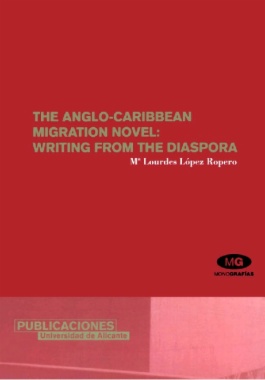Toronto, New York and London have become the new frontiers of Anglophone Caribbean literature, one of the most vibrant and prolific world literatures written in English. Drawing on new ethnographic trends, The Anglo-Caribbean Migration Novel: Writing from the Diaspora approaches Caribbean literature as a multi-centred diaspora. This book highlights the distinctiveness of the different branches of the Caribbean literary diaspora in the Anglo-American world through writers such as Samuel Selvon, Caryl Phillips, Paule Marshall, Austin Clarke and Dionne Brand. The volume is a response to the need for a deeper focus on the articulation of diversity within the Caribbean diaspora and its imaginative renderings. Lourdes López-Ropero lectures in the English Department of the University of Alicante and has published several works in the field of Postcolonial Literature.
- Cover
- TABLE OF CONTENTS
- INTRODUCTION: THE ANGLOPHONE CARIBBEAN DIASPORA
- 1. DIASPORA: CONCEPT AND CONTEXT
- 2. THE POLITICS OF DIASPORIC IDENTIFICATION
- 3. POSTULATING A CARIBBEAN DIASPORA
- 3.1. Caribbean History: An Outline
- 3.2. The Caribbean and lis Long-Standing Migration Tradition
- 3.3. The Formaüon ofa Caribbean Diaspora in the Anglo-American World: The London-New York-Toronto Axis
- 3.4. The Literary Imagination in the Caribbean Diaspora
- CHAPTER I: BRITANNIA'S OFFSPRING IN THE METRÓPOLIS: THE LONDON NOVELS OF SAMUEL SELVON AND CARYL PHILLIPS
- 1. THE POST-WAR CARIBBEAN MIGRATION TO BRITAIN
- 2. THE WINDRUSH GENERATION WRITES BACK TO THE CENTRE: SAMUEL SELVON
- 2.1. Growing Up Creolised
- 2.2. Selvon and the West Indian Literary Renaissance
- 3. BLACK MOSES IN THE BRITISH ZION: THE LONELY LONDONERS
- 3.1. Unreal City
- 3.2. Creolising the Metropolis
- 3.3. Selvon's Trinidadian English
- 3.4. Imaginary Homelands
- 4. THE IRRESISTIBLE RISE OF MULTIRACIAL BRITAIN: MOSES ASCENDING
- 4.1. The Caribbean Diaspora in the 1970s: An Update
- 4.2. Individualism and Diaspora
- 4.3. New Diasporas
- 4.4. Black Power and Immigrant Activism
- 4.5. Moses Migrating
- 5. CARYL PHILLIPS AND THE FINAL PASSAGE: FROM WINDRUSH TO SECOND GENERATION
- 5.1. In a State of Perpetual Wandering
- 5.2. Following on the Legacy
- 5.3. The Woman's Story of Migration
- 6. THAT ZION THAT is A BABYLON
- CHAPTER II: CARIBBEAN NEW YORK IN THE WORKS OF PAULE MARSHALL
- 1. THE CARIBBEAN DIASPORA IN THE UNITED STATES
- 1.1. The USA: A Country of Immigrants
- 1.2. Afro-Caribbeans in Black America
- 2. PAULE MARSHALL
- 2.1. Bridging Brooklyn and Barbados
- 2.2. Paule Marshall and Feminisms
- 3. BROWN GIRL, BROWNSTONES: BARBADÍAN NEW YORK
- 3.1. Immigrant Success and Its Acquisitive Ethic
- 3.2. Barbadian English Across Generations
- 3.3. The Human Cost of Immigrant Success
- 3.4. Afro-Caribbeans, African-Americans and Jews: Inter-Ethnic Relations
- 3.5. Myths of Homeland and Return
- 4. TRANSNATIONALISM: CONTEMPORARY PATTERS OF MIGRANT FLUIDITY IN DAUGHTERS
- 4.1. Contrapuntal Visions
- 4.2. Transmigrancy
- 4.3. Language Polyphony and Intra-Racial Relations
- 5. BASEMENTS AND BROWNSTONES
- CHAPTER III: SHATTERING CANADIAN MYTHS: THE CARIBBEAN-CANADIAN ENCOUNTER IN AUSTIN CLARKE'S TORONTO NOVELS
- 1. CANADIAN IMMIGRATION HISTORY AND ITS CARIBBEAN COMPONENT
- 1.1. Immigration and Canadian Nation-Building
- 1.2. Multiculturalism and Its Discontents
- 1.3. The Caribbean Tile in the Mosaic
- 2. CARIBBEAN-CANADIAN WRITING AND THE CANADIAN LITERARY CANON
- 2.1. The Canadian Literary Scene: The Formation of a Canadian Canon
- 2.2. Austin Clarke: From One Colony to Another
- 3. NO MEETING POINTS
- 3.1. Ethnic Hierarchies in the Canadian Mosaic
- 3.2. The Distinctiveness ofthe Caribbean-Canadian Experience
- 3.3. The Multiple Solitudes of Canadian Life: Black/Jewish Relations
- 4. SEARCHING FOR THE BIGGER LIGHT: THE PERFORMANCE OF CITIZENSHIP
- 5. DIONNE BRAND: FOLLOWING THE LEGACY OF AUSTIN CLARKE
- 6. THAT ENGLAND THAT IS NOT ENGLANd
- CONCLUSIONS
- BIBLIOGRAPHY

